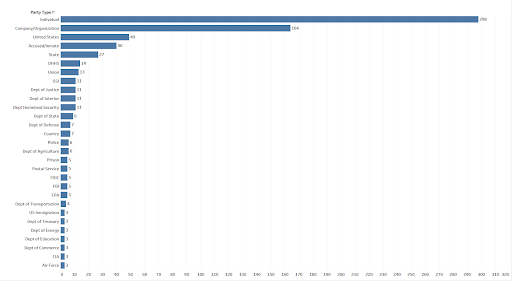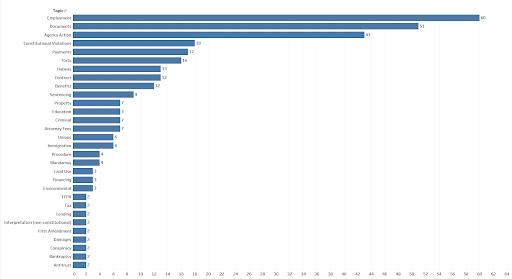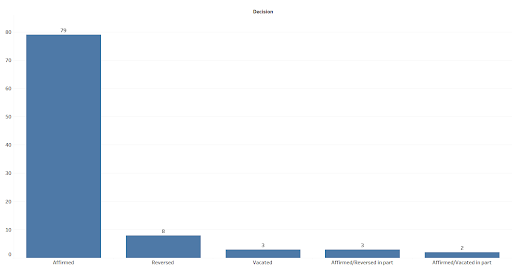Just The Stats: Ketanji Brown Jackson As A District Court Judge
The cases Judge Jackson decided, the people involved, and how her decisions fared on appeal.

Judge Ketanji Brown Jackson (Photo by H2rty via Wikimedia Commons)
This post has a bevy of statistics related to Judge Jackson’s decisions as a judge on the District Court for the District of Columbia, which helps paint a picture of the cases Judge Jackson decided, the people involved, and how her decisions fared on appeal.
Some aggregate statistics and other information on Judge Jackson’s background in law can be found on her questionnaire for nominee to the Supreme Court.
According to her questionnaire, Judge Jackson authored 578 “opinions, dispositive orders, and orders affecting injunctive relief” while on the district court, along with two opinions as a judge on the D.C. Circuit Court of Appeals. Most of these opinions can be found in a database compiled for a previous post.
Judge Jackson was on the District Court for D.C. from March 2013 through June 2021. The breakdown of the opinions she authored per year based on the database looks as follows:

In 2014 Judge Jackson authored the most opinions with 92, while she authored the fewest opinions of years where she was on the Court for the full year in 2019 with 48.
Like most district court judges, Judge Jackson’s cases dealt mainly with individuals in civil and criminal contexts.

The minimum number of cases per party type in this graph was three. Since Judge Jackson sat on the District Court for D.C., which is the court of first impression for most agency related cases, many of her cases related to executive agencies including the Department of Health and Human Services, Social Security, and the Department of Justice. The District of Columbia was also a party in many of Judge Jackson’s cases (under the heading “State”), as were corporations, the United States, and unions.
Much variation exists in the case topics Judge Jackson decided as is shown below.

Topics are shown above if there were at least two cases per topic. The most common areas were cases dealing with employment issues, followed by document requests (through FOIA), executive agency related cases, and cases dealing with constitutional violations.
An example of an employment related case is Crawford v. Johnson. In that case James Crawford complained that he was discriminated against, had a hostile work environment, and was retaliated against for engaging in a protected activity while working for the Department of Homeland Security. Many of the other employment cases also dealt with complaints from individuals working in the federal government.
One way to distinguish between the cases Judge Jackson decided is by the number of citations to them. Below is a list of the number of citations to Judge Jackson’s opinions in instances where there were at least 20 cites to them.

The case with the most citations is United States v. Lee with 125. This was a criminal case decided in 2020 where Hartley James Lee was indicted for unlawful possession of a firearm as a convicted felon, in violation of 18 U.S.C. § 922(g). Much of the case was described early in Judge Jackson’s opinion:
“Lee argues that, ‘[w]hen [he] was initially detained, circumstances were different’ (Def.’s Mot. at 5), and that, now, ‘[t]he close contact and conditions of incarceration are unsafe in light of the [COVID-19] global pandemic … [and] pose a substantial risk of serious illness and possible death’ (id. at 2). Lee’s motion further contends that, ‘[u]nder these unique circumstances, the Court must release Mr. Lee, at least until the resolution of this case.’ (Id.; see also Def.’s Reply at 4.)”
In this case Judge Jackson ruled that “ … the generalized risks posed by the COVID-19 pandemic do not alter the individualized balance of the statutory factors that Congress prescribed for determining the propriety of the defendant’s detention in this particular case, and the Court is also not persuaded that the generalized risk of contracting COVID-19, without more, constitutes a ‘compelling reason’ for Lee’s temporary release at this time.”
The case with the second most cites is Si v. Laogai Research Foundation with 74. This was a case brought under the False Claims Act challenging business practices related to the misuse of federal grant funding. While most of the counts were dismissed, Judge Jackson held that the pleading standards for a retaliation claim were met and so that plaintiff could proceed on that count.
The only case decided by Justice Jackson that was later taken en banc was American Meat Institute v. Department of Agriculture. This case was brought by meat industry trade associations against the Department of Agriculture challenging country of origin labelling for certain products. Judge Jackson’s opinion was affirmed by the D.C. Circuit panel and was affirmed once again by the D.C. Circuit en banc.
Many of Judge Jackson’s decisions like the one in American Meat Institute case were later appealed. The vast majority of these decisions were affirmed as is shown below.

Only eight of Judge Jackson’s opinions were reversed, three were vacated, and five were either affirmed and reversed in part or affirmed and vacated in part.
These data can be broken down more granularly to look at the directions the D.C. Circuit Judges voted in these appeals.

Judge Henderson voted in the most cases decided by Judge Jackson in the court below. He affirmed the most decisions of any judge with 15 affirming votes, had the most reversal votes with three (Judges Edwards and Griffith also voted to reverse in three instances), and voted to vacate the most decisions also with three.
Another judge worth focusing on is Judge Jackson’s potential future colleague on the Supreme Court, Justice Kavanaugh.
While on the D.C. Circuit, Justice Kavanaugh voted to reverse two of Judge Jackson’s opinions or 18% of the cases Judge Jackson ruled on that Justice Kavanaugh later helped decide on appeal. Justice Kavanaugh also authored both of these reversals.
The first appeal reversing Judge Jackson’s decision was in Limnia, Inc. v. U.S. Dep’t of Energy. This case dealt with Department of Energy grants for loan applications from Limnia which is an electric car company.
Judge Jackson decided to remand the case back to the Department of Energy which previously rejected Limnia’s loan applications. Justice Kavanaugh’s opinion determined that the remand was improper, and the case should be decided by the District Court for D.C. rather than the Department of Energy.
The second reversal came in Von Kahl v. Bureau of Nat’l Affairs, Inc. This case was based on defendant Von Kahl’s conviction for the murder of two U.S. Marshals and later petition for mandamus. After the petition, the Bureau of National Affairs reported that aspects of the comments made in the court below came from the sentencing judge when in fact they were made by the prosecutor.
Von Kahl sued the Bureau for defamation. Judge Jackson reasoned that the defamation claim could overcome the motion for summary judgment due to the inaccuracy in the Bureau’s report.
On appeal though Justice Kavanaugh (then Judge Kavanaugh) along with Judges Rogers and Wilkins decided that Judge Jackson should have granted the Bureau’s motion for summary judgment and so they remanded the case back to the District Court for D.C. with those instructions.
It will be interesting to see the differences (and possibly similarities) in Judge Jackson and Justice Kavanaugh’s jurisprudence if Judge Jackson is confirmed to the Court, as well as how Judge Jackson fits alongside the other justices. Once again, you can find more data on all of Judge Jackson’s decisions as well as links to these decisions here.
Read more at Empirical SCOTUS…
Adam Feldman runs the litigation consulting company Optimized Legal Solutions LLC. For more information write Adam at [email protected]. Find him on Twitter: @AdamSFeldman.







